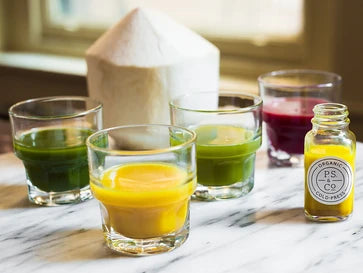Chickpeas, commonly referred to as garbanzo beans, are an old-world pulse within the legume family. A pulse is an edible seed from a legume plant. Pulses include lentils, beans, and peas as well. For instance, a pea pod is considered a legume, but the peas inside are the pulse. The same goes for soybeans, peanuts, and fresh beans. Chickpeas are incorporated into many dishes because of their versatility and nut-like flavor profile.
Chickpeas prefer semiarid and temperate regions and are thought to have had an origin in ancient Egypt and the Levant. According to the Food and Agriculture Organization (FAO) of the United Nations, over 14.2 metric tons of chickpeas were harvested worldwide in 2014. India is currently the world’s leading producer of chickpeas. There are two different types of chickpeas, the smaller dark Desi variation or the light seeded Kabuli type.

Health Benefits of the Chickpea
-
Dietary Fiber - We are huge proponents of fiber in the P.S.& Co. family. Fiber is unfortunately America’s shortfall nutrient with upwards of 97% of us eating below the recommended amount. Dietary fiber contains lignin, various plant substances, and poly/oligosaccharides. This type of fiber, insoluble, is the indigestible part of plant foods that promote healthy bowel movements.
-
Vitamins and Minerals - Adding chickpeas to one’s diet have shown higher nutrient intakes of vitamin A, vitamin E, vitamin C, magnesium, folate, potassium, and polyunsaturated fatty acids.
-
Weight Management - Yes, everyone’s favorite benefit, weight loss and/or management. Chickpeas are known to play a very important role in not only glucose and insulin regulation but weight management as well. The dataset NHANES 2003–2010 showed that people who regularly consumed chickpeas are 53% less likely to be obese and 51% less likely to have an elevated glucose level. Also as stated in the dietary fiber section, chickpeas are loaded with fiber and fiber plays a crucial role in weight loss as well. Happy gut, happy scale.
-
Heart Health - Chickpea consumption is said to have a positive impact on some markers of cardiovascular disease (CVD). Bringing fiber into the mix again, soluble fiber has shown positive effects on TC (triglycerides) and LDL-C (low-density lipoprotein cholesterol), which are biomarkers of heart disease.
Easy on the Wallet
The ongoing rumor that eating plant-based is expensive is a huge misrepresentation of the diet. Ingredients like chickpeas, beans, grains, fruits, and vegetables are not only 100% necessary for a health-forward diet but are incredibly cost-effective as well. When things do get pricier rolling down the conveyor belt in the grocery store, it’s usually because of pre-packaged foods, highly processed foods, and mock meats and cheeses. Eating a whole foods, plant-based diet is quite different from eating just a vegan diet that may include these mentioned processed items. I like to do a test in the store…don’t even walk down the aisle with pre-packaged sugar, sodium, and chemical-loaded foods. Fill up on fresh whole produce and bulk grains and legumes and see that you not only have plenty of food to live on but some of the most nutrient-dense options in the store. You also won’t be sweating during checkout because this will be an exponentially cheaper option.
Pro-tips to Stay Budget-Friendly on a Plant-Based Diet
-
Buy in bulk! Check out international stores to buy a restaurant-supply-sized bag of brown rice or other available whole grains.
-
Those same international stores also tend to have large bags of dried chickpeas. Better on the wallet and dried chickpeas need to be soaked which are more digestible for gut health than the canned variety.
-
Shop local! It not only tastes better and is better for the environment but local fruit and vegetables tend to be less expensive as well, especially in their peak seasons.
-
Avoid using or use pre-packaged, processed plant-based options sparingly.
-
Avoid pre-cut, pre-peeled, etc. fruits and vegetables in the grocery store. The labor and additional packaging cause the store to slap a higher price tag on them.
-
If you aren’t 100% organic (like our restaurant is), explore conventional options that are local.
-
Load up on bulk frozen fruits and vegetables
How Do I Use Chickpeas in a Culinary Sense?
Western chickpea consumption is quite noticeably driven through the intake of hummus. Hummus is a dip usually paired with pita, chips, or raw vegetables. It’s made from cooked, mashed chickpeas and blended with olive oil, tahini, lemon juice, and various spices. Hummus is great and all but there are an exorbitant amount of variations to add chickpeas into your culinary creations. They can be seasoned and roasted for a healthy snack. They can be added to salads, curries, grain bowls, falafel, tabbouleh, or various Indian dishes.



How P.S. & Co. Incorporates Chickpeas into Our Menu
-
Organic Burmese Chickpea Curry - A Burmese family recipe, this curry is full of healing ingredients including soaked chickpeas, turmeric, caramelized onions, and best served with sticky turmeric brown rice, Burmese fried onions, toasted sesame seeds, and heaping servings of lacinato and curly kale. The very best way to get your dark leafy greens, fiber, and nutritious spices all at once.
-
Organic Tomato & Garbanzo Bisque - A healthful blend of soaked garbanzo beans, tomatoes, carrots, celery, lacinato kale, and other healing ingredients.
-
Our Organic House-Made Marshmallows - Aquafaba (the liquid left from soaked chickpeas) is whipped into a fluffy binder agent and added to occasional dessert options.
-
Our Organic Royal Icings - made with superfood powders such as pitaya and butterfly pea flower.
-
Organic Meringue for our tarts also uses aquafaba, including the Lemon Meringue Tarts we offered for Valentine’s Day this week.
-
Organic Miso - Added to many of our dishes, our miso paste uses chickpeas instead of soybeans as its base.
https://www.ncbi.nlm.nih.gov/pmc/articles/PMC5188421/
https://www.hsph.harvard.edu/nutritionsource/legumes-pulses/





Leave a comment
This site is protected by hCaptcha and the hCaptcha Privacy Policy and Terms of Service apply.